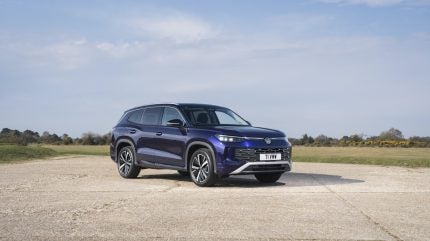
Known as the Tayron L Pro in China and as the Tiguan in North America, here in Europe the new Tayron replaces the Tiguan Allspace. The three names are, on the face of it, strange but there is logic to what Volkswagen is doing.
The world first saw this model at the Beijing motor show back in April 2024, FAW-VW’s Tayron L Pro supplementing the Tiguan there. It has five seats and a 2,791 mm wheelbase, the architecture is MQB Evo and production is at two plants: Anting and Changchun.

Discover B2B Marketing That Performs
Combine business intelligence and editorial excellence to reach engaged professionals across 36 leading media platforms.
Sales are brisk in the world’s largest market, wholesales numbering 17,515 in June though the Tiguan L, Magotan, Sagitar, Passat and of course, the Lavida, are even better performers. Clearly, Chinese buyers like what they see. Competitor brands might have impressive sales some months but will they be able to outsell the VW over a multi-year life cycle?
Global build: China, Mexico and Germany
Due to planning for the global manufacturing framework taking place years ago, it’s suddenly unfortunate that Volkswagen of America finds its new, 2026 model year Tiguan is built in a less than ideal place. Not China but instead, Mexico, the rebodied and bigger vehicle being sourced out of Puebla.
The Tayron for Europe, which is more or less the same 4,792 mm long vehicle, had its public premiere at the Paris motor show last October, production starting up one month later. This is in one of the Wolfsburg factories and on the same Line (#4) as the Touran, Golf and Tiguan.
There are multiple drive systems as well as five- and seven-seat layouts. And with a life cycle which should endure until 2032 (after a facelift in 2028 or 2029), the current powertrains will be refined and added to during the latter half of this decade.
Seven powertrains, two auto gearboxes
Already, the line-up of what’s available is impressive. Each of the following is linked to a DSG (six speeds for the PHEVs, seven for all others), no matter the number of seats, fuel or whether drive to the front axle is supported by a 4MOTION-branded 4×4 system:
- 110 kW (150 PS) 1.5 eTSI (48 V mild hybrid)
- 150 kW (204 PS) 2.0 TSI, 4MOTION
- 195 kW (265 PS) 2.0 TSI, 4MOTION
- 150 kW (204 PS) 1.5 eHybrid (PHEV), 19.7 kWh net battery
- 200 kW (272 PS) 1.5 eHybrid (PHEV), 19.7 kWh net battery
- 110 kW (150 PS) 2.0 TDI
- 142 kW (193 PS) 2.0 TDI, 4MOTION
Volkswagen UK lent me an R-Line specification eTSI. Despite having only 250 Nm of torque being sent to its front wheels, the 1.5-litre mild hybrid would likely be perfectly fine for the typical owner, namely a family buyer. The boot is huge and the car itself seemed bigger than the Tiguan Allspace which it replaces. When I checked, yes that’s true, length being up by 70 mm.
Far lighter than equivalent EVs
Unladen weight is quoted as 1,723 kilos which, in the context of EVs around the same size, is fairly good, which is partly why average WLTP consumption can be as impressive as 50.7 mpg. The official worst number is 33.3, while CO2 is 150g/km, 0-62 mph takes 9.4 seconds and the top speed is 127 mph.
If a big boot is the priority and a Touareg (4,902 mm long) doesn’t fit either the garage or the budget, then the Tayron delivers. Capacity is 705 litres as a five-seater (and the PHEVs come in that form only, incidentally, due to their battery’s location) but 850 with seven seats. And even with all places occupied there is still 345 litres behind the third row or 1,905 with the second and third rows folded. Five-seat variants’ equivalent maximum space is 1,905 litres.
On the outside, the look is unquestionably new-style VW and that includes the debut of an illuminated emblem front and back, the first in a non-electric Volkswagen SUV for the European market. Wheels, which can be up to 20 inches in diameter, fill the arches, these being flanked by dark grey plastic outlines, connected by side skirts in the same colour and material.
Customised exterior lighting
The front and rear ends feature illuminated central elements which connect the headlights and tail lights and on some trims, the owner may customise these. The same applies to lighting across the dashboard and on the door cards, while the main screen, at 320 mm diagonally, is very much on the large side. I found it to be a little too big and bright at night but not everybody will agree.
Volkswagen’s continued tweaks to its love it or hate it volume slider work perfectly in the Tayron while there is also a real dial for those who prefer that. If you want to deactivate Lane Assist and Speed Warning, and each is fairly intrusive, it’s three presses on the screen. Alas, it reset when the ignition is switched off.
The 48 V powertrain includes a 14 kW and 56 Nm belt starter-generator and the Tayron seems to collect kinetic energy fairly easily as the engine is often very quiet indeed and ‘coasting’ tends to happen a lot on motorways. I have tried this 1.5 MHEV in other Volkswagen Group models and it almost makes you question why anyone would choose a PHEV instead. But an ultra-low CO2 number matters greatly for many purchases of course.
Summary
Is the new Tayron now the class-best? It’s certainly a contender for that ranking though its in-house rival the Skoda Kodiaq might have something to say about that. The VW isn’t as pricey as people might presume it to be, at least if you keep the options-ticking to a minimum, and the flexibility of its interior, with the sliding middle row in seven-seat form, could be the deal-clincher for lots of buyers.
The as-tested VW Tayron (‘TIE-ron’) R-Line 1.5 eTSI 150 PS 7-speed DSG is priced from GBP41,655 (RRP). Pricing does however start at GBP40,130 (Life) with trim levels being Life, Match, Elegance, R-Line and R-Line Edition.






